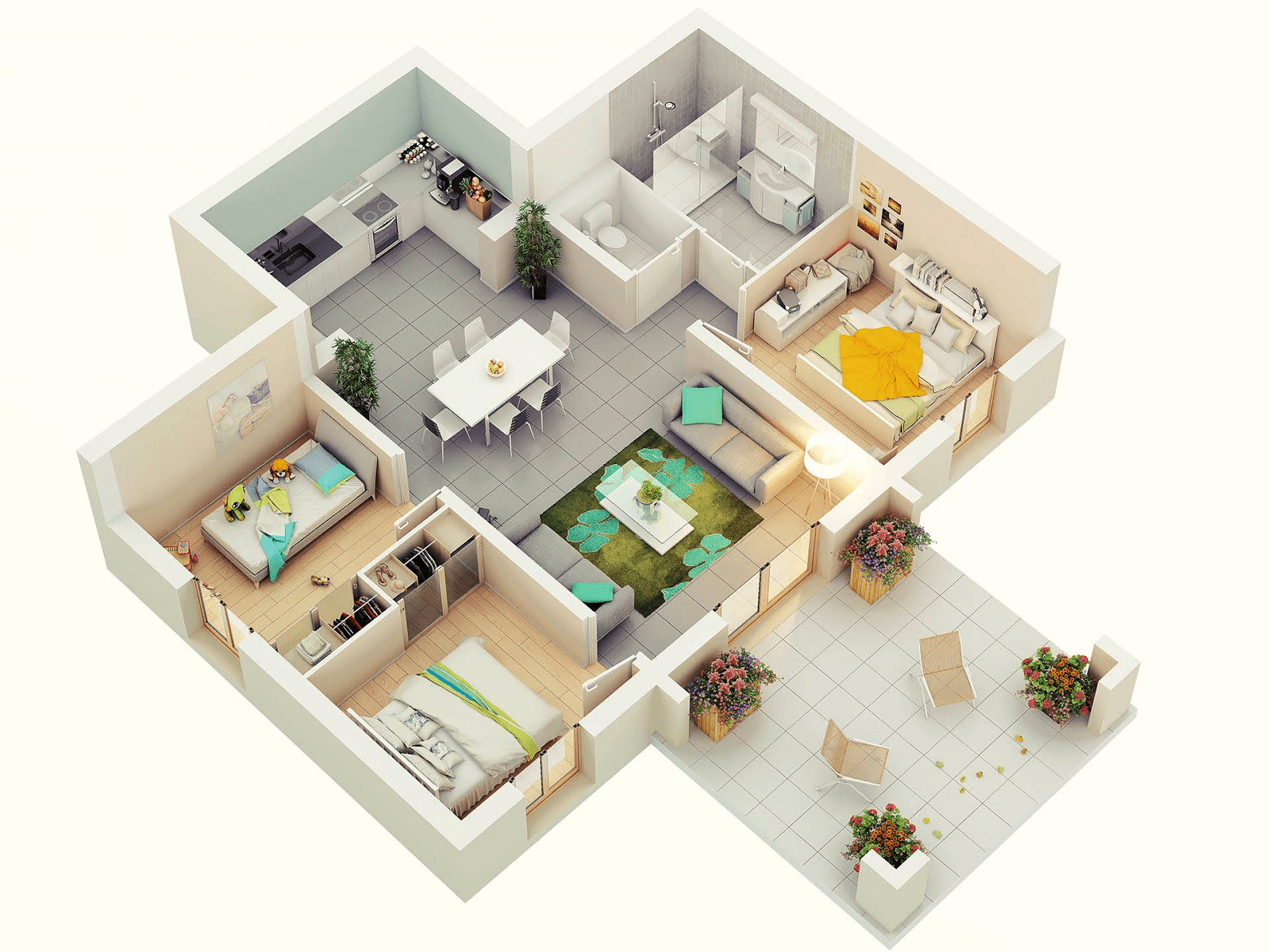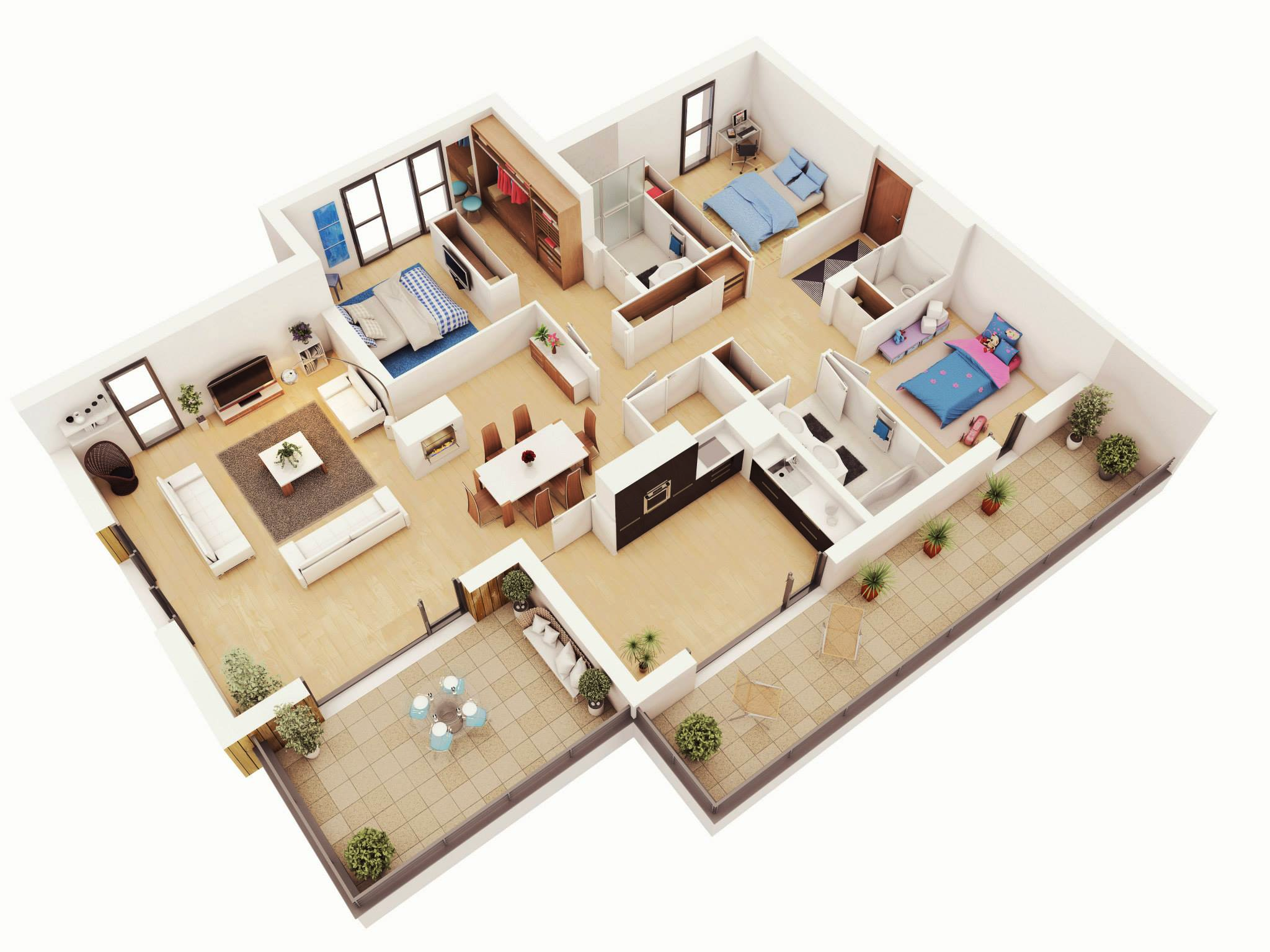Understanding 3 Bedroom House Plans

A 3-bedroom house plan is a common and versatile choice for families and individuals seeking comfortable living spaces. These plans offer a balance of functionality and flexibility, accommodating various lifestyle needs.
Typical Layout of a 3-Bedroom House Plan
A typical 3-bedroom house plan features a layout that prioritizes functionality and flow. It usually includes a living area, dining area, kitchen, bathrooms, and the three bedrooms.
- The living area serves as the central gathering space, often connecting to the dining area and kitchen for an open-concept feel.
- The kitchen is typically located near the dining area, facilitating meal preparation and serving.
- The bedrooms are generally positioned for privacy and comfort, with each room offering sufficient space for sleeping, storage, and personal belongings.
- Bathrooms are strategically placed to provide convenience for residents, with the master bedroom often featuring an ensuite bathroom for added privacy.
Key Considerations for Designing a 3-Bedroom House Plan
The design of a 3-bedroom house plan involves careful consideration of various factors to ensure functionality, aesthetics, and suitability for the intended occupants.
- Lifestyle: The lifestyle of the intended occupants plays a crucial role in determining the layout and features of the house. For example, a family with young children may require a larger living area, while a couple may prioritize a spacious master bedroom.
- Budget: The budget for the construction project sets limits on the size, materials, and finishes used in the house. A realistic budget allows for effective planning and resource allocation.
- Lot Size and Shape: The size and shape of the building lot influence the overall design and orientation of the house. It determines the footprint of the structure, the placement of windows and doors, and the flow of natural light.
- Climate: The climate of the location where the house is built impacts design considerations such as insulation, ventilation, and window placement. Adapting the design to the climate can enhance energy efficiency and comfort.
- Accessibility: For individuals with mobility challenges, accessibility features such as ramps, wider doorways, and grab bars are essential considerations in the design process.
Common Features of 3-Bedroom House Plans
3-bedroom house plans often incorporate common features that enhance functionality and livability.
- Open-Concept Living Spaces: Open-concept living areas are popular in modern homes, creating a sense of spaciousness and promoting social interaction.
- Master Suite: A master bedroom suite typically includes a private bathroom, walk-in closet, and sometimes a separate sitting area or balcony.
- Laundry Room: A dedicated laundry room provides a convenient space for washing, drying, and ironing clothes.
- Storage Space: Adequate storage space is essential in a 3-bedroom house to keep belongings organized and clutter-free.
- Outdoor Living Areas: Patios, decks, or balconies provide additional living space for outdoor relaxation and entertaining.
Designing a 3 Bedroom House Plan: Drawing Of A 3 Bedroom House Plan

Designing a 3-bedroom house plan involves careful consideration of various factors, including the size of the family, lifestyle, budget, and the available land. This process is a blend of creativity and practicality, aiming to create a comfortable and functional home that meets the specific needs of the occupants.
Steps in Designing a 3-Bedroom House Plan
The design process typically involves several steps:
- Define the Requirements: Start by identifying the essential needs of the family. Consider the number of bedrooms, bathrooms, living spaces, kitchen size, and any specific features like a home office or a guest room.
- Choose a Style: Explore different architectural styles like contemporary, traditional, farmhouse, or modern. Each style has unique characteristics and design elements that can influence the overall look and feel of the house.
- Plan the Layout: This involves determining the arrangement of rooms, hallways, and staircases. Consider the flow of traffic, natural light, and privacy needs for each space.
- Select Materials: Choose building materials that align with the chosen style and budget. Consider factors like durability, energy efficiency, and aesthetics.
- Finalize the Design: Review the plan and make any necessary adjustments before proceeding with construction. This ensures that the design meets all requirements and is functional for the family.
Examples of 3-Bedroom House Plan Styles, Drawing of a 3 bedroom house plan
Different architectural styles offer unique aesthetics and functional layouts for 3-bedroom homes. Here are a few examples:
- Contemporary Style: Characterized by clean lines, open floor plans, and large windows that maximize natural light. These homes often feature minimalist decor and a focus on functionality.
- Traditional Style: Emphasizes symmetry, intricate details, and classic architectural elements like columns and gables. These homes often have formal living spaces and a sense of grandeur.
- Farmhouse Style: Features rustic charm, with elements like exposed beams, stone fireplaces, and large porches. These homes typically have a warm and inviting atmosphere.
- Modern Style: Focuses on simplicity, functionality, and innovative materials. These homes often feature open floor plans, minimalist decor, and a focus on sustainable design principles.
Designing a 3-Bedroom House Plan for a Family with Young Children
Designing a 3-bedroom house plan for a family with young children requires specific considerations:
- Child-Friendly Spaces: Designate separate play areas that are safe, stimulating, and easily accessible. Consider using soft flooring materials and rounded furniture corners to minimize the risk of injuries.
- Storage Solutions: Incorporate ample storage options for toys, clothes, and other children’s belongings. This helps maintain a sense of order and keeps the house tidy.
- Safety Features: Install safety gates at the top and bottom of stairs, and consider using childproof locks on cabinets and drawers.
- Outdoor Play Area: Designate a dedicated outdoor space for children to play, ideally with a fenced-in area for safety.
- Easy Cleaning: Select materials and finishes that are easy to clean, as children can often create messes.
Analyzing 3 Bedroom House Plans

Choosing the right 3-bedroom house plan can be a complex process, as there are many factors to consider and numerous design options available. This section explores different 3-bedroom house plan designs, their advantages and disadvantages, and key factors to consider during the selection process.
Comparing and Contrasting 3-Bedroom House Plan Designs
Different 3-bedroom house plans offer various layouts and features to suit different lifestyles and preferences. Understanding the key differences can help you choose the best plan for your needs.
- Open-Concept vs. Traditional Layouts: Open-concept plans offer a spacious and airy feel by combining living, dining, and kitchen areas, promoting a sense of togetherness. Traditional layouts, on the other hand, feature distinct rooms with defined boundaries, offering privacy and separation. Open-concept plans can be more challenging to manage noise levels, while traditional layouts can feel more confined.
- Master Suite Variations: Master suites can be designed with various features, including walk-in closets, en-suite bathrooms, and separate sitting areas. Larger master suites offer luxury and privacy, while smaller suites might prioritize space efficiency.
- Second Floor vs. Single-Story Plans: Two-story plans maximize space on a smaller footprint, offering more bedrooms and living areas. However, they can be less accessible for individuals with mobility limitations. Single-story plans provide easy access and are more suitable for families with young children or elderly individuals.
- Modern vs. Traditional Aesthetics: Modern house plans often feature clean lines, minimalist designs, and large windows, emphasizing natural light. Traditional plans, on the other hand, often incorporate classic architectural elements, such as gables, columns, and porches.
Advantages and Disadvantages of Different 3-Bedroom House Plan Layouts
Understanding the advantages and disadvantages of different 3-bedroom house plan layouts can help you make informed decisions.
- Open-Concept Layouts:
- Advantages: Spacious and airy feel, promotes social interaction, allows for flexibility in furniture arrangement.
- Disadvantages: Can be noisy, difficult to manage clutter, may not offer enough privacy.
- Traditional Layouts:
- Advantages: Provides privacy and separation, easier to manage noise levels, offers more defined spaces for different activities.
- Disadvantages: Can feel more confined, less flexibility in furniture arrangement, may not offer as much natural light.
- Master Suite Variations:
- Large Master Suites: Offers luxury and privacy, can include amenities like walk-in closets, en-suite bathrooms, and sitting areas.
- Small Master Suites: Prioritizes space efficiency, may not include all the amenities of a larger suite.
- Second Floor vs. Single-Story Plans:
- Two-Story Plans: Maximizes space on a smaller footprint, offers more bedrooms and living areas, can be more visually appealing.
- Single-Story Plans: Provides easy access, more suitable for families with young children or elderly individuals, can be less expensive to build.
- Modern vs. Traditional Aesthetics:
- Modern Plans: Clean lines, minimalist designs, large windows, emphasizes natural light, can be more expensive to build.
- Traditional Plans: Classic architectural elements, such as gables, columns, and porches, can be more expensive to build, may not be as energy-efficient as modern plans.
Key Factors to Consider When Choosing a 3-Bedroom House Plan
Choosing the right 3-bedroom house plan involves considering several factors.
- Lifestyle and Needs: Consider your family size, activities, and lifestyle preferences. For example, a family with young children might prioritize a single-story plan for accessibility, while a family that enjoys entertaining might prefer an open-concept layout.
- Budget: House plans vary in cost based on size, complexity, and materials used. Determine your budget and explore plans that fit within your financial constraints.
- Location and Climate: Consider the climate and local building codes when choosing a house plan. For example, a plan with large windows might be ideal in a sunny climate, while a plan with more insulation might be necessary in a colder climate.
- Accessibility: If you or someone in your family has mobility limitations, choose a plan with features like wide doorways, ramps, and accessible bathrooms.
- Energy Efficiency: Consider energy-efficient features, such as insulation, high-performance windows, and solar panels, to reduce energy consumption and save money on utility bills.
Drawing of a 3 bedroom house plan – Drawing a 3 bedroom house plan can be a fun and challenging project. You can use it to visualize your dream home, complete with a spacious living area, a comfortable kitchen, and of course, three bedrooms. If you’re looking for a similar experience without the construction, you can explore the diverse options for 3 bedroom apartments in Tampa Palms.
After all, a well-designed floor plan, whether for a house or an apartment, can be a great starting point for creating a cozy and functional living space.
Drawing a 3 bedroom house plan allows you to visualize the layout and flow of your future home. If you’re considering an apartment instead, you might want to explore the options for a 3 bedroom apartment in Valencia. Once you’ve settled on the type of dwelling, you can fine-tune your drawing to reflect the specific features and amenities that matter most to you.